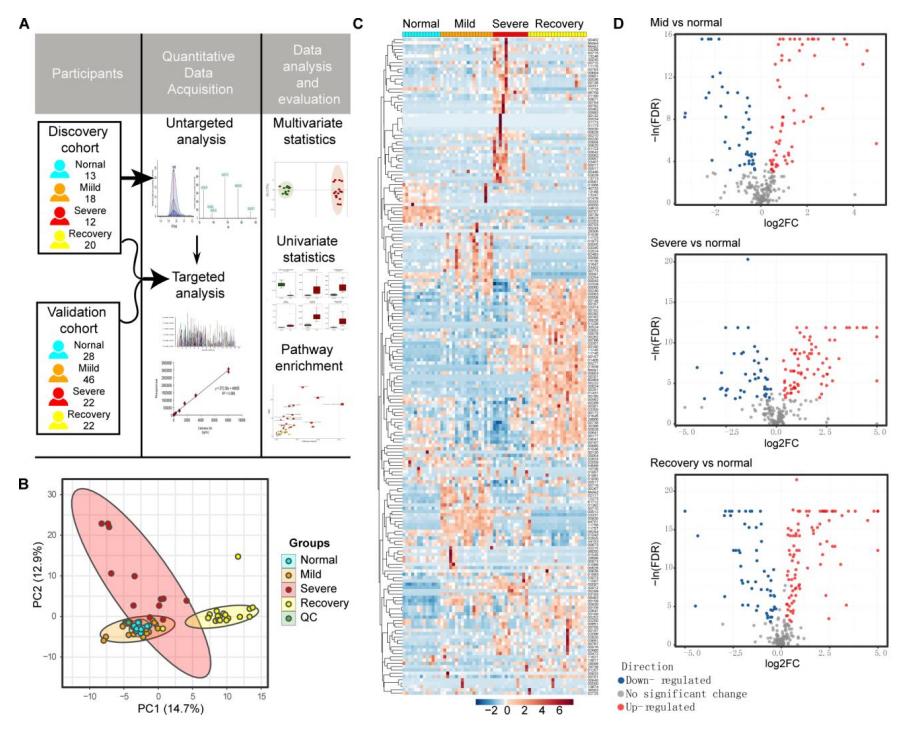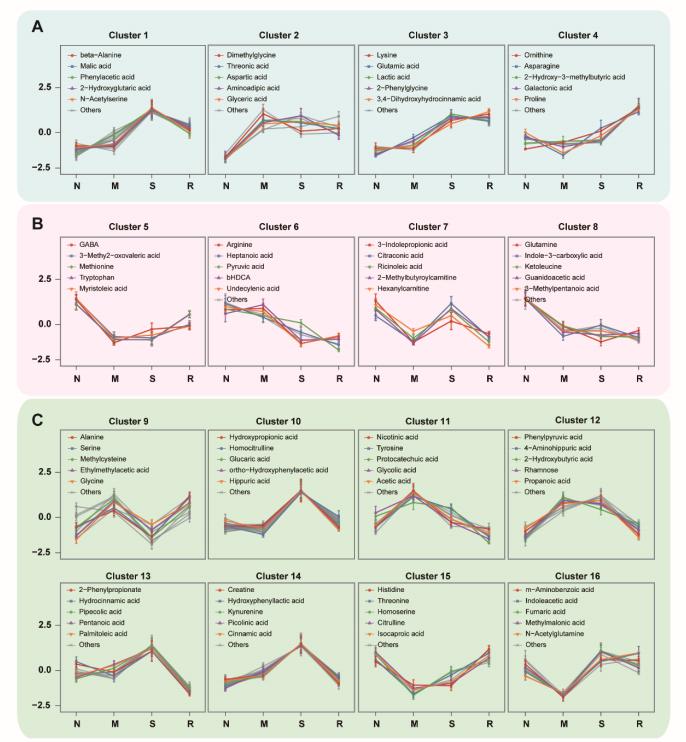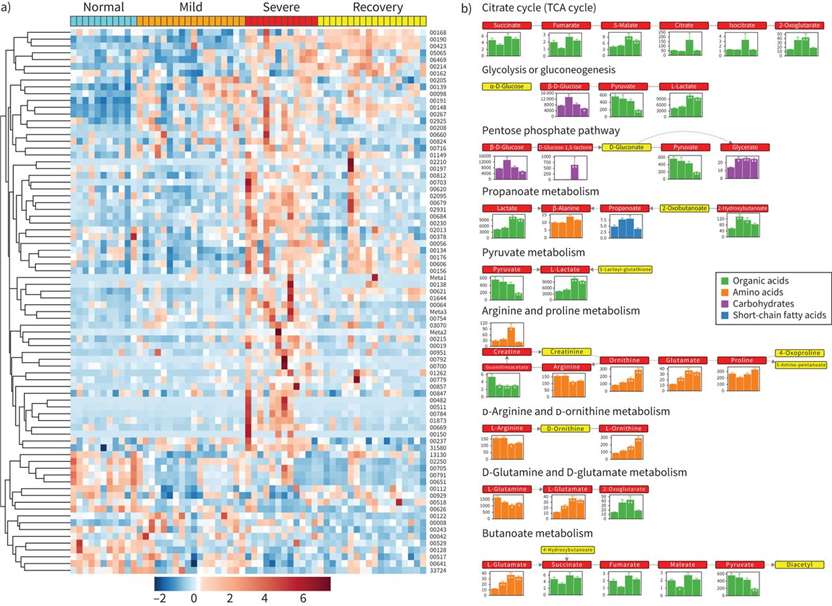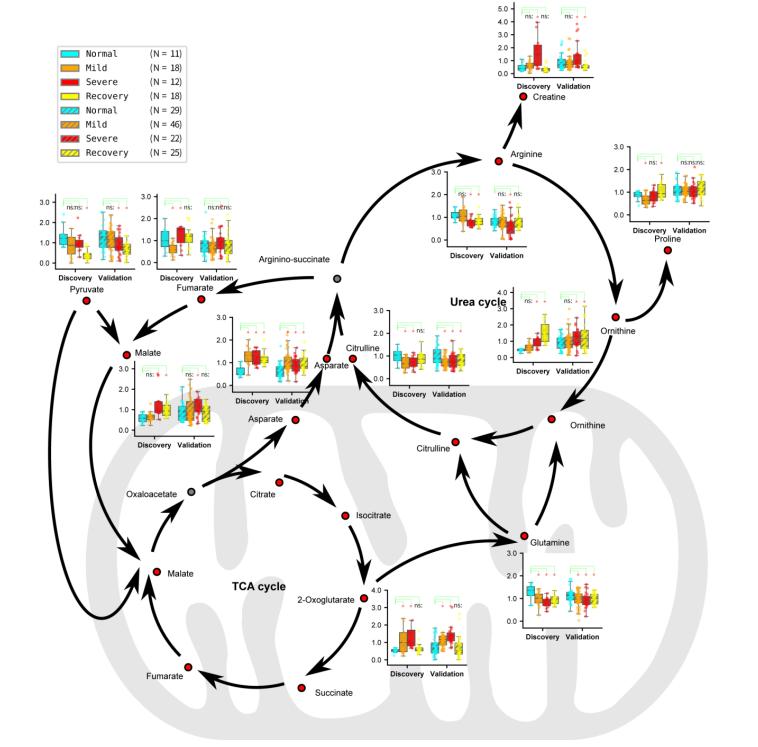COVID-19 caused by SARS-CoV-2 has been classified as a major global pandemic by the World Health Organization. Identifying the underlying molecular mechanisms of COVID-19 is critical to overcome this pandemic. The use of untargeted metabolomics and targeted metabolomics analysis allows for a comprehensive view of the metabolic profile of COVID-19 patients at all stages of serum.
1. Serum untargeted metabolomic analysis of patients in the developmental stage of COVID-19
Compared to patients with mild disease, patients with severe disease had significantly suppressed lymphocytes and elevated leukocytes and AST (aspartate aminotransferase), suggesting immune system and liver dysfunction.
A total of 240 metabolites were identified by untargeted metabolomic analysis of all serum samples from the discovery cohort. Metabolites in the mild disease group partially overlapped with the normal group, while the severe disease and recovery groups were easily distinguished (Figure 1B). 193 of the 240 metabolites were significantly associated with COVID-19 (Figure 1C). Volcano plots show the up-regulation and down-regulation of metabolites in different groups compared to the normal group (Figure 1D). Among the important metabolites, many amino acids were associated with disease severity, such as glutamine, glutamate, arginine, ornithine, kynurenine, and tryptophan. Some metabolites are involved in the TCA cycle and become disordered with the development of COVID-19, such as glucose, lactate, and pyruvate.

Figure 1. Serum untargeted metabolomic analysis of all COVID-19 developmental stage patients in the discovery cohort. (A) Study design; (B) principal component analysis (PCA) of four sets of non-targeted metabolomics; (C) heat map of 193 metabolites; (D) volcano map
2 Targeted metabolomics reveals metabolite trends in COVID-19 patients
Targeted metabolomic analysis of sera from 59 subjects of the discovery cohort quantified 199 metabolites. Metabolites were grouped into 16 clusters based on their concentration in different groups (Figure S3). These clusters were divided into three groups based on whether the metabolites returned to normal levels in the recovery group (Figure S3A-C). The concentrations of metabolites in Figure S3A increased with disease progression and were maintained at higher levels in the recovery group. The concentrations of metabolites in Figure S3B decreased with disease progression and did not return to normal levels in the recovery group. Metabolite concentrations in Figure S3C returned to near-normal levels.

Figure S3 Targeted metabolomics reveals trends in metabolite changes at different stages of the discovery cohort. (A) higher than normal group; (B) lower than normal group; (C) comparable to normal group
3 Changes in major metabolites and pathways at different stages
Eighty of the 199 metabolites were significantly different in at least one phase compared to the normal group (Figure 2A). Pathway analysis revealed dysregulation of aspartate metabolism, urea cycle, arginine and proline metabolism, glycine and serine metabolism, and TCA cycle (Figure 2B). Together, the altered tricarboxylic acid cycle, pyruvate metabolism, and glycolysis indicated disturbed energy metabolism, a finding supported by the extremely high lactate levels in the severe group. This may be due to the fact that even with respiratory support, patients are still unable to obtain oxygen efficiently, thus creating a significant impairment in energy metabolism. This phenomenon was also found in patients who experienced severe illness into the recovery group, suggesting that even when SARS-CoV-2 was completely cleared, the damage remained for some time, or for a very long time (Figure 2B).

Figure 2 Changes in major serum metabolites found at different stages of the cohort. (A) Heat map of metabolites quantified by targeted metabolomics; (B) Pathway analysis showing significant differences in amino acid metabolism
4 Dysregulation of the urea cycle and TCA cycle in COVID-19 development
The urea cycle, responsible for amino acid metabolism, and the TCA cycle, responsible for energy metabolism, are the Top2 affected metabolic pathways. (Figure 3). The 11 metabolites belonging to or closely related to these two pathways had significant variations between groups in the discovery cohort (Figure 3). In the validation cohort, 9 of the 11 metabolites showed significant variation between groups (Figure 3). These nine metabolites were creatine, arginine, ornithine, aspartate, pyruvate, malate, citrulline, glutamine, and 2-ketoglutarate.

Figure 3 Dysregulated urea cycle and TCA cycle may be involved in disease development
Resources
- Jia, H., Liu, C., et al. (2022). Metabolomic analyses reveal new stage-specific features of COVID-19. European Respiratory Journal, 59(2).








